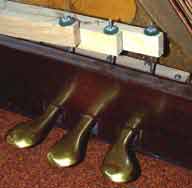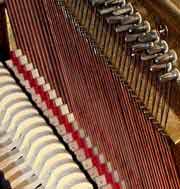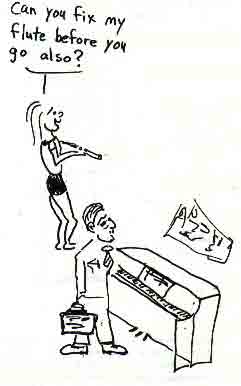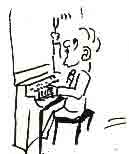|
|
 |
 |
 |
|
|
 |
 |
 |
|
Humidity Tuning Pins Soundboards Strings The Action The Cabinet Moving |
Text by Roy E. Howard ©2002 Cantos
Para Todos Manufacturers recommended care instructions Piano Cleaning products: http://professionalpianoproducts.com/ |
|
PIANO CARE by Roy E. Howard, Ph.D. If there are pianos in heaven, what would they be like? I hope they would be in better condition than some I have seen. You can be sure that many of the pianos in homes today would not qualify for any celestial glory! It is certain that pianos do need a certain degree of care and attention. Yet many homes in America have pianos that do not receive hardly any degree of care or attention. One reason for the lack of attention is a general lack of accurate knowledge about pianos and their special needs. Piano teachers and piano owners should be informed about principles of piano care. |
Factors affecting the intonation include changes in humidity (the piano goes sharp or flat in certain sections as the sound board expands and contracts) and the passage of time (piano wire loses its tension over time and the sound goes flat). |
|
In spite of what you may have heard or done in the past, here is the straight fact about tuning frequency: Manufacturers of all sizes and qualities of pianos repeatedly tune them in the factory. Stores have the pianos tuned (or should to maintain pitch) about every three months. Manufacturers then recommend that the piano be tuned every three months the first year in the home or studio, then twice per year thereafter. Concert and recording studio pianos are tuned before every event. In my years of tuning, I have found that a new piano that is reasonably well built and is in an adequate environment will become more stable with each tuning. The magic number seems to be six. After six tunings, most pianos will sound adequate for home use between annual tunings, whether the six tunings are done in two years as recommended or stretched out over several years. Older pianos are harder to predict. A piano that has had regular tunings some time in its life may be able to maintain a reasonable pitch level even if neglected for several years. A piano that has not had regular tunings may be unable to hold any tuning. There is a simple soloution for such a piano: tune it regularly and often until it becomes stable enough to maintain its pitch and an acceptable tuning for a year. If the piano does not need a pitch raise, a tuning can be expected to last six to twelve months. If it does need a pitch raise, the frequency of the tunings needed depends on how much the pictch is raised and the tightness of the tuning pins. Changes in humidity may change the tuning the next day or week after the piano tuner is done. |
I just bought a used piano. Could you tell me if I paid the right price? |
|
Piano tuning is a complex process that requires specialized training and a great deal of practice. It has been said that a novice needs to tune five hundred pianos before he understands what to listen for and one thousand more before he is working consistently. Piano owners don't need to know how to tune a piano, but can learn to communicate more intelligently with the tuner if they understand some of what he is doing. The tuner manipulates a large number of steel pins that are driven tightly into a hardwood block (pin block or wrestplank), thus tightening or loosening the stiff wire strings. |
The process is complicated by the fact that the wire passes over, under along side of, or through several friction points. As the tuning lever exerts or releases tension at the pin, the wire is tightened or loosened at each successive part of its length. The string is in tune when the speaking length (the part that vibrates when struck by the hammer) vibrates at the desired number of cycles per second (such as A=440 cycles per second). |
|
Every string sounds harmonic partials in addition to the basic pitch. The stiffness of the wire contributes to "inharmonicity", the phenomenon of physics that makes a piano impossible to tune exactly to an organ or violin or even to another piano. The tuner "tempers" the scale and "stretches" the octaves to make the instrument sound in tune with itself as much as possible. The physical nature of the piano wire and the enormous range of the instrument make it impossible to eliminate beats. Even the finest tuner cannot eliminate all beats in the unisons, let alone the octaves and other intervals. The tuner manipulates the beats to create the most harmonious sound possible. A smaller piano is even more difficult to tune because the shorter strings are stiffer and thus have less accurate harmonic partials and therefore greater inharmonicity. Many musicians can recognize beats in a note as a "vibrato" sound when unisons are not in tune, or string inharmonicity by hearing a "tinny" sound, especially in a piano with short strings. Some people assume that a tuner would need "perfect pitch" to do such an enormous task. However, perfect pitch is a term used by musicians to describe their ability to memorize pitches for singing without an accompaniment. The tuner would be handicapped if he could not adjust his sense of pitch to each instrument. In addition to tuning, the technician may judge the need to do any of thousands of other possible adjustments when the piano is tuned. Common simple jobs include adjusting pedal action, tightening loose screws, or adjusting action parts. These are discussed more fully in this chapter in the section on regulating the action. |
|
The soundboard expands and contracts with changes in temperature and humidity. Humidity change is the greatest factor causing tuning variations in a piano not suffering from the string stretching described above. Fortunately, a dry, stable climate, like many parts of the Southwest, is very favorable to piano stability and longevity. Unfortunately, the insidious swamp cooler, the water cooled air conditioner, takes its toll. One summer I was called to the home of a fine piano teacher with a beautiful grand piano. I was embarrased and perturbed by the degree to which the piano had changed in the two or three months since I had last tuned it. The middle register was high, dampers and keys sticking, and nearly every note uncomfortably out of tune. I did not take long to discover the culprit: the swamp cooler! |
 |
|
I have restored pianos that have slid down stairways, fallen out of pickup trucks and suffered through home fires. However, the worst I have seen is caused by the least dramatic enemy: drying out. The worst examples of this I saw in Washington State. Pianos would come from the wet side of the mountains (Seattle) to the dry side (Wenatchee) and just fall apart. The keys and hammers get loose and rattle. The cabinet and finish crack and peel. The tuning pins get so loose that the piano cannot be tuned. More than once I have had to declare such a piano "dead". In New Mexico and West Texas, such severity is less often seen. Then, it is most often with a piano that has come from a more humid place. Each state has different conditions affecting tuning pin tightness. Piano owners should consult with experienced piano tuners for the advice most appropriate for their situation. |
|
 |
Many times I have heard people tell me that the last tuner "would not raise the pitch because the strings might break". Most often I then did the pitch raise without problem. String breakage is no more serious on a piano than on any other string instrument. If a string breaks, we simply replace it or repair it. String breakage becomes serious only when a large number of strings break in any section of the piano. For example, strings may break is a certain section of the bass only, or just of a certain section of the treble. Sometimes it is strings of all the same gauge. In many of these cases, the solution is a relatively inexpensive replacement of the poor section. Complete restringing is usually indicated when the strings break and the pins are also loose.
Proper functioning of the piano depends on the coordination of almost fifty different action parts for each of the eighty-eight notes, including the keys, hammers, dampers, etc. Among the thousands of parts involved, there are almost one thousand friction points. Each part, moving or static, must be adjusted to match the others. "Action regulating" is a process that includes repairing, renewing, and bringing each of these into a tolerance of one thousandth of an inch for the purpose of providing the player with consistent, controlled "touch". Some manufacturers suggest that although a concert instrument is regulated for every performance, a home piano that gets normal use should have the action regulated every two or three years. Some researchers suggest that over ninety percent of the pianos never receive this type of care, resulting in the touch being one of the most frustrating factors in piano playing. Tuning is also a struggle when the action is not regulated. |
|
Some tuners will struggle with "first aid" adjustments of parts that do not work, feeling that a customer might balk at the suggestion of an expensive regulation job. The twenty or thirty steps that must be done for each key can take eight ot twelve hours of concetrated effort charged at an hourly rate. A piano that is regulated every few years, however, may require much less time to maintain excellent touch. To give an idea of the complexity of the process, note the steps from a checklist for regulating a vertical piano: Remove action, tighten all screws, reshape hammers, clean piano and action, make necessary repairs, align and tighten regulation rail, align damper lift rod, travel hammers, space hammers to strings, space and square backchecks, space and square keys, set hammer stroke, regularte key capstans and key height, level white keys, then sharp keys, regulate hammer letoff, white key dip, hammer checking, sharp key dip, dampers to damper lift rod, sustaning pedal to damper lift rod, damper spoons, soft pedal, and bridle tapes. Piano players may notice the need for action regulation when the tone is not even from one note to the next, the overall touch is too light or too stiff, individual notes do not respond quickly or damp properly, or keys are sticking. Since each piano and piano player are different, setting the action to the "regulated" standards may not provide the desired results. For fine adjustments, the player may cooperate in the action regulation by playing the piano for a few days between each set of procedures by the technician. Many problems can be solved with patience, others may require a different piano! Voicing is an advanced procedure for adjusting the tone of a well regulated and tuned piano. it involves additional string to hammer regulating, hardening hammers by removing layers of felt or by chemicals, or softening hammers by carefully calculated and controlled jabs with needles, and even adjustments to the strings. The main object of voicing is finding a note with an acceptable tone, and adjusting the hammers and action of the other notes so the tone is even in all ranges of playing dynamics. Some piano players request that a technician try to "voice down" the overall bright tone of a piano, or to brighten a piano with dull tone. Sometimes these effects may be achieved by moving the piano to a different part of the room in order to change the relative position of walls, carpeting, or other physical features that affect room acoustics. In this series of photos, the technician checks the strike point, the hammer shape, and the felt density before needling the felt. |

|
 |
5. Protecting enroute. Wrap it. Don't let the breezes blow on it. Keep it dry. Jarring may cause a piano with loose pins to become untuned. The piano has many thousands of delicate parts that can be easily broken. Be careful. 6. Moving in. Avoid heater and air vents, sunlight, and drafts when considering where to place the piano in the home. Consider the need for humidity controls in the piano if the new location is much drier or more humid than the last. 7. Selecting a tuner. Follow the recommendation of a reputable dealer or teacher. If such advise is not available, consider a tuner who has been certified reliable by the Piano Technician's Guild. Tune after wiaint two to four weeks for the piano to adjust to its new environment. 8. Cabinet repairs. If needed, call a refinishing shop and inquire about an expert in "touch-up". Not all refinishers have this special skill. 9. Action, string and soundboard repairs. Ask the tuner before he comes if he is equipped for such repairs. Not all tuners are technicians, not all technicians are rebuilders. 10. Your next move. Now you are experienced and probably know how much a mover can help. Be sure that you ask if the mover is experienced and equipped for piano moving. Ask your tuner's advice at each end of the move. |
|
 go to Howard Piano Service go to Howard Piano Service
|